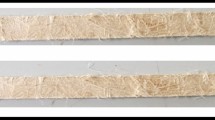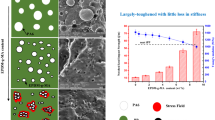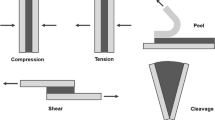Abstract
Due to the graded micro-structure and high specific strength-stiffness, bamboo micro fillers are systematically utilized in reinforcing different thermoset and thermoplastic polymers as replacement of conventional glass and carbon fillers. In this work, micro-size bamboo particle fillers are reinforced in ‘specific grade’ thermoset epoxy matrix and its fracture properties has been evaluated by following linear elastic fracture mechanics. To enhance its compatibility with the polymer matrix and to reduce the hydrophilicity, the bamboo micro fillers are surface modified through alkaline treatment. The extent of surface modification and removal of lower weight polymers from filler surface are examined and established by Fourier transform infrared (FTIR) spectroscopy, X-ray diffraction analysis and thermogravimetric analysis. The fracture properties of bamboo-epoxy composite material are observed to be increasing with the addition of bamboo fillers and the maximum value of fracture toughness is 0.678 MPa.m0.5 which is 32% higher than the same for neat epoxy samples. In addition, the mechanisms of notch initiated fracture propagation have also been explained for the understanding of stress singularity present at the preexisted crack tip.















Similar content being viewed by others
References
Nagarajan V, Mohanty AK, Misra M (2016) Perspective on Polylactic acid (PLA) based sustainable materials for durable applications: focus on toughness and heat resistance. ACS Sustain Chem Eng 4:2899–2916
Gross RA, Kalra B (2002) Biodegradable polymers for the environment. Science 297(5582):803–807
Haque MM, Islam MS, Islam MN (2012) Preparation and characterization of polypropylene composites reinforced with chemically treated coir. J Polym Res 19(5):9847
Rahman MM, Netravali AN, Tiimob BJ, Rangari VK (2014) Bioderived “green” composite from soy protein and eggshell Nanopowder. ACS Sustain Chem Eng 2:2329–2337
Kumar R, Kumar K, Sahoo P, Bhowmik S (2014) Study of mechanical properties of wood dust reinforced epoxy composite. Procedia Mater Sci 6:551–556
Anand P, Rajesh D, Kumar MS, Raj IS (2018) Investigations on the performances of treated jute/Kenaf hybrid natural fiber reinforced epoxy composite. J Polym Res 25(4):94
Liu D, Song J, Anderson DP, Chang PR, Hua Y (2012) Bamboo fiber and its reinforced composites: structure and properties. Cellulose 19:1449–1480
Kumar R, Bhowmik S, Kumar K (2017) Establishment and effect of constraint on different mechanical properties of bamboo filler reinforced epoxy composite. Int Polym Process 32(3):308–315
Kabir MM, Wang H, Lau KT, Cardona F (2012) Chemical treatments on plant-based natural fibre reinforced polymer composites: an overview. Compos Part B 43:2883–2892
Li X, Tabil LG, Panigrahi S (2007) Chemical treatments of natural fiber for use in natural fiber-reinforced composites: a review. J Polym Environ 15:25–33
Kushwaha PK, Kumar R (2010) Bamboo fiber reinforced thermosetting resin composites: effect of graft copolymerization of fiber with methacrylamide. J Appl Polym Sci 118:1006–1013
Nirmal U, Hashim J, Low KO (2012) Adhesive wear and frictional performance of bamboo fibres reinforced epoxy composite. Tribol Int 47:122–133
Yu Y, Huang X (2014) Yu W (2014) a novel process to improve yield and mechanical performance of bamboo fiber reinforced composite via mechanical treatments. Compos Part B 56:48–53
Khalil AHPS, Bhat IUH, Jawaid M, Zaidon A, Hermawan D (2012) Hadi YS (2012) bamboo fibre reinforced biocomposites: a review. Mater Des 42:353–368
Rajulu AV, Baksh SA, Reddy GR, Chary KN (1998) (1998) chemical resistance and tensile properties of short bamboo fibre reinforced epoxy composites. J Reinf Plast Compos 17:1507–1511
Liu H, Wu Q, Han G, Yao F, Kojima Y, Suzuki S (2008) Compatibilizing and toughening bamboo flour-filled HDPE composites: mechanical properties and morphologies. Compos Part A 39:1891–1900
Zhou XX, Yu Y, Chen LH (2015) Effects of zirconaluminate coupling agent on mechanical properties, rheological behavior and thermal stability of bamboo powder/polypropylene foaming composites. Eur J Wood Prod 73:199–207
Thakur VK, Kessler MR (2014) Synthesis and characterization of AN-g-SOY for sustainable polymer composites. ACS Sustain Chem Eng 2(10):2454–2460
Kumar R, Kumar K, Bhowmik S (2017) Assessment and response of treated Cocos nucifera reinforced toughened epoxy composite towards fracture and viscoelastic properties. J Polym Environ 26:1–14. https://doi.org/10.1007/s10924-017-1150-y
Henke L, Zarrinbakhsh N, Endres HJ, Misra M, Mohanty AK (2017) Biodegradable and bio-based green blends from carbon dioxide-derived bioplastic and poly (butylene succinate). J Polym Environ 25(2):499–509
Nagarajan V, Mohanty AK, Misra M (2016b) Biocomposites with size-fractionated biocarbon: influence of the microstructure on macroscopic properties. ACS Omega 1(4):636–647
Dang W, Kubouchi M, Yamamoto S, Sembokuya H, Tsuda K (2002) An approach to chemical recycling of epoxy resin cured with amine using nitric acid. Polymer 43(10):2953–2958
Gorrasi G, Sorrentino A (2015) Mechanical milling as a technology to produce structural and functional bio-nanocomposites. Green Chem 17(5):2610–2625
Mishra S, Misra M, Tripathy SS, Nayak SK, Mohanty AK (2001) Graft copolymerization of acrylonitrile on chemically modified sisal fibers. Macromol Mater Eng 286:107–113
Shekhawat A, Ritchie RO (2016) Toughness and strength of nanocrystallinegraphene. Nat Commun 7:10546
Behazin E, Misra M, Mohanty AK (2017) Sustainable biocarbon from pyrolyzed perennial grasses and their effects on impact modified polypropylene biocomposites. Compos Part B 118:116–124
Kafy A, Kim HC, Zhai L, Kim JW, Kang TJ (2017) Cellulose long fibers fabricated from cellulose nano fibers and its strong and tough characteristics. Sci Rep 7(1):17683
Nam S, French AD, Condon BD, Concha M (2016) Segal crystallinity index revisited by the simulation of X-ray diffraction patterns of cotton cellulose Iβ and cellulose II. Carbohydr Polym 135:1–9
French AD (2014) Idealized powder diffraction patterns for cellulose polymorphs. Cellulose 21(2):885–896
Sa Y, Guo Y, Feng X, Wang M, Li P, Gao Y, Yang X, Jiang T (2017) Are different crystallinity-index-calculating methods of hydroxyapatite efficient and consistent? New J Chem 41(13):5723–5731
Segal LGJMA, Creely JJ, Martin Jr AE, Conrad CM (1959) An empirical method for estimating the degree of crystallinity of native cellulose using the X-ray diffractometer. Text Res J 29(10):786–794
Abidi N, Cabrales L, Eric H (2010) Thermogravimetric analysis of developing cotton fibers. Thermochim Acta 498:27–32
Li Y, Jiang L, Xiong C, Peng W (2015) Effect of different surface treatment for bamboo Fiber on the crystallization behavior and mechanical property of bamboo Fiber/Nanohydroxyapatite/poly (lactic-co-glycolic) composite. Ind Eng Chem Res 54(48):12017–12024
Ferreira MVF, Neves ACC, de Oliveira CG, Lopes FPD, Margem FM, Vieira CMF, Monteiro SN (2017) Thermogravimetric characterization of polyester matrix composites reinforced with eucalyptus fibers. J Mater Res Technol 6(4):396–400
Kumar R, Kumar K, Bhowmik S (2018) Mechanical characterization and quantification of tensile, fracture and viscoelastic characteristics of wood filler reinforced epoxy composite, wood Sci. Technol 52(3):677–699
Monteiro SN, Calado V, Rodriguez RJS, Margem FM (2012) Thermogravimetric behavior of natural fibers reinforced polymer composites—an overview. Mater Sci Eng A 557:17–28
Spanoudakis J, Young RJ (1984) Crack propagation in a glass particle-filled epoxy resin. J Mater Sci 19(2):473–486
Wong KJ, Yousif BF, Low KO, Ng Y, Tan SL (2010) Effects of fillers on the fracture behaviour of particulate polyester composites. J Strain Anal Eng Des 45(1):67–78
Goyat MS, Suresh S, Bahl S, Halder S, Ghosh PK (2015) Thermomechanical response and toughening mechanisms of a carbon nano bead reinforced epoxy composite. Mater Chem Phys 166:144–152
Singleton ACN, Baillie CA, Beaumont PWR, Peijs T (2003) On the mechanical properties, deformation and fracture of a natural fibre/recycled polymer composite. Compos Part B 34(6):519–526
Li Y, Zhou Q, Zhang S, Huang P, Xu K, Wang F, Lu T (2018) On the role of weak interface in crack blunting process in nanoscale layered composites. Appl Surf Sci 433:957–962
Kitey R, Phan AV, Tippur HV, Kaplan T (2006) Modeling of crack growth through particulate clusters in brittle matrix by symmetric-Galerkin boundary element method. Int J Fract 141(1–2):11–25
Khan Z, Yousif BF, Islam M (2017) Fracture behaviour of bamboo fiber reinforced epoxy composites. Compos Part B 116:186–199
James MN, Christopher CJ, Lu Y, Patterson EA (2012) Fatigue crack growth and craze-induced crack tip shielding in polycarbonate. Polymer 53(7):1558–1570
Gope PC, Rao DK (2016) Fracture behaviour of epoxy biocomposite reinforced with short coconut fibres (Cocos nucifera) and walnut particles (Juglansregia L.). J Thermoplast Compos Mater 29(8):1098–1117
Acknowledgements
The authors would like to acknowledge SAIF-IIT Bombay and SAIC-Gauhati University for providing necessary technical assistances for FTIR and XRD. The authors also would like to thank Machine element laboratory and Material testing laboratory, MED, NIT Silchar for giving essential research facilities. The first author gratefully acknowledges the Ministry of Human Resource Development (MHRD), GOI for fellowship during his PhD work.
Author information
Authors and Affiliations
Corresponding author
Ethics declarations
Conflict of interest
The author(s) declared no potential conflicts of interest with respect to the research, authorship, and/or publication of this article.
Additional information
Publisher’s note
Springer Nature remains neutral with regard to jurisdictional claims in published maps and institutional affiliations.
Rights and permissions
About this article
Cite this article
Kumar, R., Kumar, K., Bhowmik, S. et al. Tailoring the performance of bamboo filler reinforced epoxy composite: insights into fracture properties and fracture mechanism. J Polym Res 26, 54 (2019). https://doi.org/10.1007/s10965-019-1720-x
Received:
Accepted:
Published:
DOI: https://doi.org/10.1007/s10965-019-1720-x




